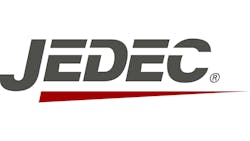JEDEC updates LPDDR5 standard for low power memory devices
ARLINGTON, VA—JEDEC Solid State Technology Association, a global standards developer for the microelectronics industry, on Tuesday announced the publication of JESD209-5, Low Power Double Data Rate 5 (LPDDR5). LPDDR5 will eventually operate at an I/O rate of 6400 MT/s, 50% higher than that of the first version of LPDDR4, which will significantly boost memory speed and efficiency for a variety of applications including mobile computing devices such as smartphones, tablets, and ultra-thin notebooks. In addition, LPDDR5 offers new features designed for mission critical applications such as automotive. Developed by JEDEC’s JC-42.6 Subcommittee for Low Power Memories, LPDDR5 is available for download from the JEDEC website.
With the doubling of memory throughput over the previous version of the standard (LPDDR5 is being published with a data rate of 6400 MT/s, compared to 3200 MT/s for LPDDR4 at its publication in 2014), LPDDR5 promises to have an enormous impact on the performance and capabilities of the next generation of portable electronic devices. To achieve this performance improvement, LPDDR5 architecture was redesigned; moving to 16Banks programmable architecture and multi-clocking architecture.
LPDDR5 introduces two new command-based operations to improve system power consumption by reducing data transmission: Data-Copy and Write-X. The Data-Copy command instructs the LPDDR5 device to copy data transmitted on a single I/O pin to the other I/O pins, eliminating the need to transmit data to the other pins. The Write-X command instructs the device to write all-ones or all-zeros to a specific address, eliminating the need to send data from the SoC to the LPDDR5 device. Reducing data transmission with these new commands will help reduce overall system power consumption.
To address the need for data reliability in adjacent markets such as automotive, LPDDR5 introduces the support of Link Error Correcting Code (ECC) on the interface between the SoC and DRAM.
Key specification updates include:
- I/O throughput up to 6400 Mbps
- Signaling voltage – 250mV
- Non-Target ODT for DQ was added to support higher data rate
- Signal integrity enhancement by DFE
- Clocking architecture: WCK & Read Strobe (RDQS) added to support higher data rate
- Programmable Multi-bank organization (8Banks, 4Bank groups/4Banks, and 16Banks)
- Selectable background and command based ZQ calibration
- Low-power features added include
- Dynamic Frequency and Voltage Scaling for Core and I/O
- Selectable differential and single-ended CK, WCK, and RDQS
- Partial array self-refresh and auto-refresh
- Low power read/write operation with Data-Copy and Write-X functions
- Function/Features targeting automotive applications including
- Optional Link ECC
- New packaging definition

